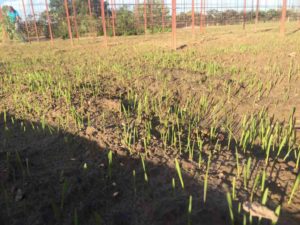
Every fall we sow hard red winter wheat in our garden. We call it “putting the garden to bed.” Most just call it planting a winter cover crop.
We usually begin sowing in late September. It can be done as late as late November. Here is how it is done :
- First, after gleaning every last tomato and pepper, we clear away all that remains in the garden. Much of the plant material at the end of the season harbors disease and/or insects so we like to remove as much as possible to another location and burn it. That way next season will start out clean and fresh. Another practice that promotes healthy gardens is to rotate crop families every year in the garden, but that is another topic for another post.
- Next, we lay down a complete fertilizer such as 10-20-10 over the entire garden with a broadcast spreader. We run the spreader north/south with half of the load and then spread the other half going east/west. This gives a more uniform cover of fertilizer.
- Lightly till the garden, going over it in one direction, and then again at 90º to that. Till only deep enough to incorporate the mulch into the soil.
- Using the broadcast spreader we then scatter our wheat seed over the garden, again splitting the amount in half and making two passes over the entire garden, one at 90º to the other. This detail evens out the spread of the seed, giving a uniform cover of wheat.
- Go over the plot one more time very lightly with the tiller. We don’t want to work the seed too deeply into the soil or it will not come up. The optimum seed depth is one inch, but the seeds will come up if just barely covered or if no more than two inches cover them.
- If rain is not in the forecast, set up sprinklers. If there is just a little moisture in the soil and it doesn’t rain within a week, the wheat could emerge and then die.

So what are the benefits of a winter cover crop in your garden, you might ask.
- Planting a cover crop helps suppress unwanted weeds over winter.
- A cover crop helps hold the soil in place, inhibiting erosion due to wind and rain.
- It also helps build organic matter into the soil which in turn helps the soil retain moisture and nutrients better.
- When mowed throughout the winter and eventually tilled back into the soil in the spring, the wheat provides a natural slow-release fertilizer.
- As you can see, a garden plot sown with wheat in the fall provide a pleasant island of green in a winter-long ocean of browns and grays. I gives you something enjoyable to look at while waiting for winter to pass.
